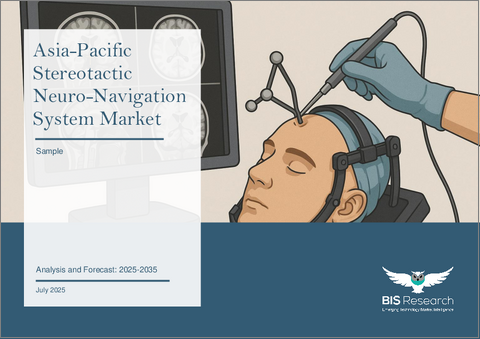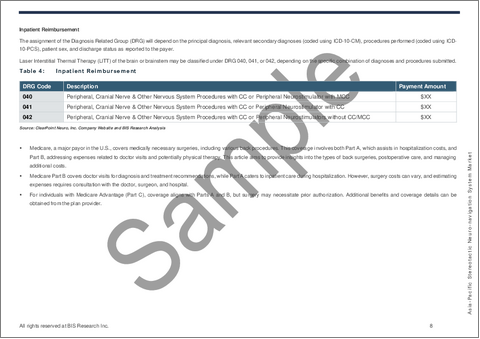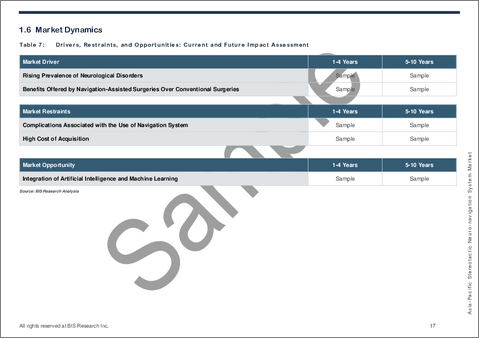|
|
市場調査レポート
商品コード
1781118
アジア太平洋地域の定位ニューロナビゲーションシステム市場:分析・予測 (2025-2035年)Asia-Pacific Stereotactic Neuro-Navigation System Market: Analysis and Forecast, 2025-2035 |
||||||
カスタマイズ可能
|
|||||||
| アジア太平洋地域の定位ニューロナビゲーションシステム市場:分析・予測 (2025-2035年) |
|
出版日: 2025年07月31日
発行: BIS Research
ページ情報: 英文 54 Pages
納期: 1~5営業日
|
全表示
- 概要
- 図表
- 目次
アジア太平洋地域の定位ニューロナビゲーションシステムの市場規模は、2024年の1億7,070万米ドルから、予測期間中はCAGR 14.05%で推移し、2035年には7億220万米ドルに成長すると予測されています。
アジア太平洋地域では、神経疾患の発症頻度の増加と、ナビゲーション支援手術が従来の手術に比べて明確な利点を持つことから、定位的ニューロナビゲーションシステム市場が急速に拡大しています。AI、機械学習、拡張現実 (AR) といった新技術の導入により、これらのシステムの臨床応用が広がると同時に、手術の安全性と精度も向上しています。特に、アジア太平洋全域で高齢化が進み、それに伴い加齢性の神経疾患が増加していることから、低侵襲手術への移行が進んでおり、高精度ナビゲーションシステムに対する需要がさらに加速しています。
| 主要市場統計 | |
|---|---|
| 予測期間 | 2025-2035年 |
| 2025年評価 | 1億8,870万米ドル |
| 2035年予測 | 7億220万米ドル |
| CAGR | 14.05% |
しかしながら、いくつかの課題が依然として存在しています。特にリソースが限られた医療環境では、初期導入費用や維持費の高さ、病院の既存IT・画像診断インフラとの統合の難しさ、手術中の問題の可能性などが、普及の妨げとなる可能性があります。それにもかかわらず、中国、インド、日本といった国々における有利な規制改革、脊椎手術や頭蓋底手術など関連分野へのナビゲーション技術の利用拡大、さらなる技術革新により、引き続き成長が見込まれています。同地域の医療インフラが成熟・発展するにつれ、定位的ニューロナビゲーション市場は今後も成長を続けると予測されています。
市場はパーキンソン病、てんかん、脳腫瘍といった神経疾患の有病率の増加を背景に、急速に拡大しています。こうした疾患に対しては、臨床成績、安全性、精度を高める画像ガイド型の高度な手術ソリューションへの需要が高まっており、定位的ニューロナビゲーションシステムは、低侵襲手術を可能にし、術中の意思決定を支援する手段として、病院や専門医療施設で広く採用されつつあります。
また、機械学習、AR、AIなどの技術革新により、ナビゲーションプラットフォームの可能性はさらに進化しています。これらの技術により、リアルタイムでの可視化、術前計画の精緻化、合併症リスクの低減が実現され、手術の質が大幅に向上しています。加えて、入院期間の短縮や回復の迅速化といった利点をもつ低侵襲神経外科手法への移行が、導入をさらに加速させています。
中国、インド、日本、韓国といった国々は、医療支出の増加、高度な外科機器に対する認知の向上、医療インフラの発展を背景に、この地域における市場拡大を牽引しています。一方で、機器の高価格、専門人材の不足、統合の複雑性といった課題は、特に発展途上国において依然として存在します。それでもなお、継続的な研究開発、規制環境の改善、臨床用途の拡大などにより、アジア太平洋地域における市場の成長は今後も持続すると見込まれています。
市場の分類:
セグメンテーション1:地域別
- アジア太平洋
- 日本
- 中国
- その他
当レポートでは、アジア太平洋地域の定位ニューロナビゲーションシステムの市場を調査し、主要動向、市場影響因子の分析、法規制環境、技術・特許の分析、市場規模の推移・予測、各種区分・地域/主要国別の詳細分析、競合情勢、主要企業のプロファイルなどをまとめています。
目次
エグゼクティブサマリー
範囲と定義
第1章 市場:業界展望
- 市場動向
- シナジー効果を活用した事業ポートフォリオの多様化
- 償還シナリオ
- 規制状況/コンプライアンス
- 日本
- 中国
- サプライチェーン分析
- 価格分析
- 市場力学
- 市場促進要因
- 市場抑制要因
- 市場機会
第2章 定位ニューロナビゲーションシステム市場:地域別
- アジア太平洋
- 地域概要
- 市場成長の原動力
- 市場課題
- 日本
- 中国
- その他
第3章 市場:競合ベンチマーキングと企業プロファイル
- 主要戦略と開発
- 製品ベンチマーク
- 企業プロファイル
- SaphireX Surgicals
- SURGLASSES Inc.
- HRS Navigation
第4章 調査手法
List of Figures
- Figure 1: Asia-Pacific Stereotactic Neuro-Navigation System Market (by Scenario), $Million, 2025, 2029, and 2035
- Figure 2: Japan Federation of Medical Devices Associations (JFMDA) Classification
- Figure 3: NMPA Classification
- Figure 4: Supply Chain and Risks within the Supply Chain
- Figure 5: Prevalence of Parkinson's Disease (by Region), 2016-2021
- Figure 6: Increasing Incidence of CNS Brain Tumor Cases (by Region), 2022, 2025, 2035, and 2045
- Figure 7: Increasing Aging Population Globally, Million, 2020-2023
- Figure 8: Asia Pacific Stereotactic Neuro-Navigation Market, Spinal Navigation Surgery, Procedure Volume, Thousands, 2023-2035
- Figure 9: Asia Pacific Stereotactic Neuro-Navigation Market, Cranial Stereotactic Surgery, Procedure Volume, Thousands, 2023-2035
- Figure 10: Asia Pacific Stereotactic Neuro-Navigation Market, $Million, 2023-2035
- Figure 11: Incidences of Neurological Disorders in Japan, Million, 2018-2021
- Figure 12: Japan Stereotactic Neuro-Navigation System Market, $Million, 2023-2035
- Figure 13: Incidences of Neurological Disorders in China, Million, 2018-2021
- Figure 14: China Stereotactic Neuro-Navigation System Market, $Million, 2023-2035
- Figure 15: Incidences of Neurological Disorders in Rest-of-Asia-Pacific, Million, 2018-2021
- Figure 16: Rest-of-Asia-Pacific Stereotactic Neuro-Navigation System Market, $Million, 2023-2035
- Figure 17: Data Triangulation
- Figure 18: Top-Down and Bottom-Up Approach
- Figure 19: Assumptions and Limitations
List of Tables
- Table 1: Market Snapshot
- Table 2: Some of the Key Developments
- Table 3: CPT Coding
- Table 4: Inpatient Reimbursement
- Table 5: Medical Devices Classification Medical Devices in Japan
- Table 6: Price of Stereotactic Neuro-Navigation System
- Table 7: Drivers, Restraints, and Opportunities: Current and Future Impact Assessment
- Table 8: Comparison between Various Navigation-Assisted Surgeries Over Conventional Surgeries
- Table 9: Sources of Error in Navigated Surgery
- Table 10: Cost of Acquisition of Key Neuro-Navigation Systems
- Table 11: Stereotactic Neuro-Navigation System Market (by Region), $Million, 2023-2035
- Table 12: Japan Incidences of Neurological Disorders, By Disease Type, 2018-2020
- Table 13: China Incidences of Neurological Disorders, By Disease Type, 2018-2020
- Table 14: Rest-of-Asia-Pacific Incidences of Neurological Disorders, By Disease Type, 2018-2020
- Table 15: Some of the Strategies and Development, January 2017-May 2025
- Table 16: Stereotactic Neuro-Navigation System Market, Product Benchmarking (by Product)
This report can be delivered in 2 working days.
Introduction to Asia-Pacific Stereotactic Neuro-Navigation System Market
The Asia-Pacific stereotactic neuro-navigation system market is projected to reach $702.2 million by 2035 from $170.7 million in 2024, growing at a CAGR of 14.05% during the forecast period 2025-2035. Strong market expansion for stereotactic neuro-navigation systems is being driven in the APAC region by the increasing frequency of neurological illnesses as well as the obvious benefits of navigation-assisted operations over traditional surgery. New technologies like artificial intelligence, machine learning, and augmented reality are expanding the clinical use of these systems while improving surgical safety and accuracy. The demand for high-accuracy navigation systems is being further accelerated by the regional shift towards minimally invasive operations, particularly as age-related neurological diseases increase due to ageing populations throughout APAC.
| KEY MARKET STATISTICS | |
|---|---|
| Forecast Period | 2025 - 2035 |
| 2025 Evaluation | $188.7 Million |
| 2035 Forecast | $702.2 Million |
| CAGR | 14.05% |
However, a number of obstacles persist. Wider use may be hampered, especially in settings with limited resources, by high acquisition and maintenance costs, challenges integrating with the hospital's current IT and imaging infrastructure, and possible intraoperative issues. Notwithstanding these obstacles, growth is anticipated to be sustained by further innovation, favourable regulatory changes in nations like China, India, and Japan, as well as the growing use of neuro-navigation in related specialities like spinal and skull base surgery. The stereotactic neuro-navigation market is expected to continue growing as healthcare infrastructure in both established and developing APAC markets improves.
Market Introduction
The market for APAC stereotactic neuro-navigation systems is expanding quickly due to the increased prevalence of neurological conditions such Parkinson's disease, epilepsy, and brain tumours. Advanced, image-guided surgical solutions that provide improved clinical results, safety, and precision are in high demand due to these diseases. Because they facilitate minimally invasive operations and enhance intraoperative decision-making, stereotactic neuro-navigation systems are becoming more and more popular in the region's hospitals and speciality centres.
The possibilities of neuro-navigation platforms are being further transformed by technological developments, such as the incorporation of machine learning, augmented reality, and artificial intelligence. Real-time visualisation, better surgical planning, and lower complication rates are made possible by these advancements. Adoption is also being accelerated by the move towards minimally invasive neurosurgery methods, which lead to shorter hospital stays and quicker recovery times.
Due to rising healthcare spending, rising awareness of sophisticated surgical instruments, and developing medical infrastructure, nations like China, India, Japan, and South Korea are spearheading the regional expansion. But issues like expensive equipment, a lack of expertise, and integration complexity still exist, especially in developing nations. Notwithstanding these obstacles, it is anticipated that continued research and development, advantageous regulatory changes, and expanded clinical uses will maintain the market's pace throughout Asia-Pacific.
Market Segmentation:
Segmentation 1: by Region
- Asia-Pacific
- Japan
- China
- Rest-of-Asia-Pacific
APAC Stereotactic Neuro-Navigation System Market Trends, Drivers and Challenges
Market Trends
- The APAC region is the fastest-growing market for stereotactic neuro-navigation systems, with a strong projected CAGR through 2030.
- Optical navigation systems are emerging as the leading technology segment due to their precision and ease of integration.
- China is the leading contributor to market growth within the region, supported by rapid healthcare advancements.
- Increasing clinical preference for image-guided neurosurgery is driving demand across both public and private healthcare institutions.
- Growing adoption of hybrid navigation platforms combining stereotactic accuracy with advanced imaging tools.
Key Drivers
- Rising incidence of neurological disorders such as brain tumors, epilepsy, and Parkinson's disease is fueling demand for advanced surgical technologies.
- Increased use of navigation-assisted minimally invasive procedures for improved accuracy and faster recovery.
- Advancements in AI, machine learning, and AR/VR are enhancing surgical planning and intraoperative precision.
- Healthcare infrastructure development in emerging economies is enabling broader access to neuro-navigation systems.
- Expanding government support and improving reimbursement scenarios in selected markets are encouraging adoption.
Major Challenges
- High capital investment and ongoing maintenance costs limit accessibility for smaller hospitals and rural facilities.
- Integration with existing hospital systems can be complex, requiring dedicated IT resources and system customization.
- Shortage of trained neurosurgeons and technical staff poses barriers to widespread system adoption.
- Diverse regulatory environments across APAC countries delay market entry and device approvals.
- Concerns around data privacy and cybersecurity due to increased connectivity in AI-enabled systems.
Key Market Players and Competition Synopsis
The companies profiled have been selected based on inputs gathered from primary experts and an analysis of company coverage, product portfolio, and market penetration.
Some prominent names established in this market are:
- Saphirex Surgicals
- SURGLASSES Inc.
- HRS Navigation
Table of Contents
Executive Summary
Scope and Definition
1 Market: Industry Outlook
- 1.1 Market Trends
- 1.1.1 Leveraging Synergies to Diversify Business Portfolio
- 1.2 Reimbursement Scenario
- 1.3 Regulatory Landscape/Compliance
- 1.3.1 Japan
- 1.3.2 China
- 1.4 Supply Chain Analysis
- 1.5 Pricing Analysis
- 1.6 Market Dynamics
- 1.6.1 Market Drivers
- 1.6.1.1 Rising Prevalence of Neurological Disorders
- 1.6.1.2 Benefits Offered by Navigation-Assisted Surgeries Over Conventional Surgeries
- 1.6.2 Market Restraints
- 1.6.2.1 Complications Associated with the Use of Navigation Systems
- 1.6.2.2 High Cost of Acquisition
- 1.6.3 Market Opportunities
- 1.6.3.1 Integration of Artificial Intelligence (AI) and Machine Learning
- 1.6.1 Market Drivers
2 Stereotactic Neuro-navigation System Market (By Region), $Million, 2023-2035
- 2.1 Asia Pacific
- 2.1.1 Regional Overview
- 2.1.2 Driving Factors for Market Growth
- 2.1.3 Factors Challenging the Market
- 2.1.4 Japan
- 2.1.5 China
- 2.1.6 Rest-of-Asia-Pacific
3 Markets - Competitive Benchmarking & Company Profiles
- 3.1 Key Strategies and Development
- 3.2 Product Benchmarking
- 3.3 Company Profiles
- 3.3.1 SaphireX Surgicals
- 3.3.1.1 Overview
- 3.3.1.2 Top Products/Product Portfolio
- 3.3.1.3 Top Competitors
- 3.3.1.4 Target Customers
- 3.3.1.5 Key Personal
- 3.3.1.6 Analyst View
- 3.3.2 SURGLASSES Inc.
- 3.3.2.1 Overview
- 3.3.2.2 Top Products/Product Portfolio
- 3.3.2.3 Top Competitors
- 3.3.2.4 Target Customers
- 3.3.2.5 Key Personal
- 3.3.2.6 Analyst View
- 3.3.3 HRS Navigation
- 3.3.3.1 Overview
- 3.3.3.2 Top Products/Product Portfolio
- 3.3.3.3 Top Competitors
- 3.3.3.4 Target Customers
- 3.3.3.5 Key Personal
- 3.3.3.6 Analyst View
- 3.3.1 SaphireX Surgicals
4 Research Methodology
- 4.1 Data Sources
- 4.1.1 Primary Data Sources
- 4.1.2 Secondary Data Sources
- 4.1.3 Data Triangulation
- 4.2 Market Estimation and Forecast





